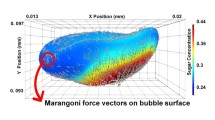Summary
Under near-equilibrium conditions from the general mass balance the radial concentration profile is calculated, with which the HETP value is established. First, the zone spreading in open helical columns and for sorbed solutes is calculated. The theory is then extended to a general velocity profile in ope and packed columns. The presented theory proves the reliability of the nonequilibrium theory but is to be preferred being more principal and general, because radial asymmetrical velocity profiles can be handled too, and only the near-equilibrium assumption is needed. The theory can be used for other column geometries too.
Zusammenfassung
Ausgehend von der allgemeinen Massenbilanz wird mit nur geringer Abweichung vom Gleichgewicht das radiale Konzentrationsprofil berechnet, von welchem die Trennstufenhöhe bestimmt wird. Zuerst wird die Bandeverbreiterung für das Sorbat in spiralförnigen Kapillaren berechnet. Die Theorie wird dann erweitert für ein allgemeines Geschwindigkeitsprofil in Kapilaren und gepackten Säulen. Die vorgelegte Theorie zeigt die Gültigkeit der Nicht-Gleichgewichts-Theorie, aber ist dieser wegen ihrer allgemeineren und grundsätzlichen Anwendbarkeit vorzuziehen, denn sie erlaubt auch die Behandlung von radial asymmetrischen Geschwindigkeitsprofilen und benötigt nur die Annahme einer geringfügigen Abweichung vom Gleichgewicht. Die Theorie gilt auch für Säulen anderer Geometrie.
Résumé
Il est possible de calculer, pour un système dans un état voisin de l'équilibre, en partant du bilan général de masse, le profil de concentration selon la direction radiale. Ainsi, on peut déterminer la valeur équivalente à un plateau théorique. On peut d'abord calculer l'étalement d'une zone de soluté «adsorbé» dans le cas d'une colonne capillaire enroulée en spirale. Ensuite on peut donner une théorie plus générale pour chaque profil de vitesse dans le cas d'une colonne capillaire aussi bien que dans le cas d'une colonne remplie. La théorie présentée montre la validité de la théorie du non-équilibre Cette théorie est préférable parce qu'elle est plus importante et plus générale: avec cette théorie, on peut traiter des profils de vitesse dissymmétriques par rapport à la direction radiale, tout en admettant une faible déviation de l'état d'équilibre lors des calculs. Il est aussi possible de traiter les cas où la forme des colonnes est différente.
Similar content being viewed by others
Literature
R. Tijssen: Chromatographia3 (1970) 525.
R. Courant, D. Hilbert: Methoden der mathematischen Physik II, Berlin 1968, p. 230.
J. C. Giddings: Dynamics of Chromatography I, New York 1965, p. 154.
see [1] fig. 2..
part III, to be published in Chromatographia.
A. B. Littlewood in: Gas Chromatography (ed. Goldup-Brighton 1964) London 1965, p. 81.
J. C. Giddings, J. Chromatogr.3 (1960) 520.
J. M. Matsen, J. W. Harding, J. Chromatog.,12 (1963) 145
G. W. Johnson: Thesis Renselaer Polytechnic Institute, Troy, New York (1967).
Author information
Authors and Affiliations
Rights and permissions
About this article
Cite this article
Tijssen, R., Wittebrood, R.T. Effect of column-coiling on the dispersion of solutes in gas chromatography. Part II: Generalized theory. Chromatographia 5, 286–295 (1972). https://doi.org/10.1007/BF02268588
Issue Date:
DOI: https://doi.org/10.1007/BF02268588




